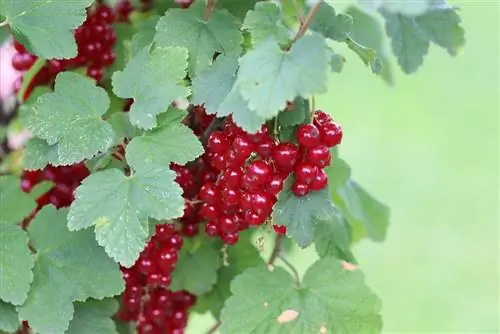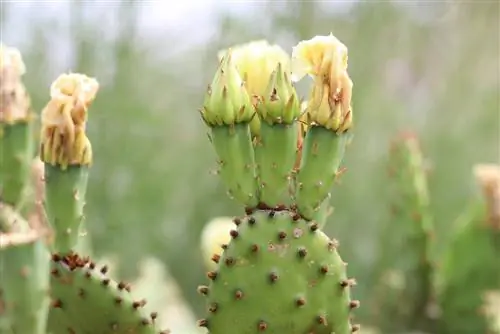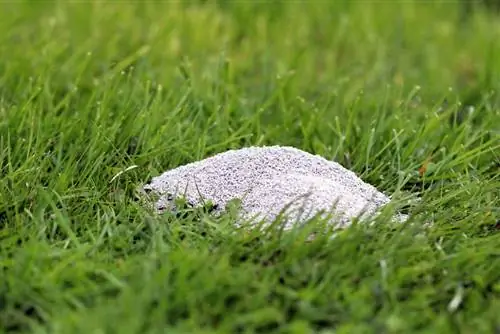- Author admin [email protected].
- Public 2023-12-17 03:39.
- Last modified 2025-06-01 06:48.
Berry plants produce their first yields quickly. These become more lush the larger the bush gets. If you want to optimize yields, you should use a good fertilizer. The plants receive important nutrients that are specifically optimized for their needs. If you fertilize correctly and regularly, you can have a positive influence on the growth of the plants and the yields.
Large variety of varieties
Berry fruit comes in many different varieties. New tasty variants are regularly added through crossbreeding and breeding. Raspberries, currants and gooseberries are particularly popular. So you can choose raspberry varieties that bear fruit in both early summer and autumn. Currants come in different colors and also differ in taste. Regardless of which variety you choose, you should choose a suitable location for the plants and include regular fertilization in your care.
Berry plants have low requirements
The plants and bushes on which the soft fruit grows are basically undemanding. This means you can plant your most popular berry varieties regardless of the condition of your soil. She will develop well at first. This applies not only to the berries that grow on bushes, but also to the popular strawberries. You can always get new varieties of strawberries that differ from the classic varieties that produce in spring.
Some varieties bear all year round, others in autumn. And because the strawberry is so popular, it is cultivated in a variety of ways. Of course, you still have the option of planting classic varieties in a bed in the garden. Strawberries are perennial plants that grow larger every year. If you add a high-quality berry fertilizer to the soil, you will benefit from a very good harvest in the second year at the latest.
The strawberry as the most popular type of berry
If you don't have a large garden, you don't have to miss out on enjoying strawberries. You get varieties for pots and containers that bear fruit all year round. For these varieties, a liquid fertilizer is more suitable than a powder fertilizer. You can dose liquid fertilizer better in pots and buckets and they dissolve more quickly. These strawberry plants are also perennial, but they need protection in winter because they do not grow in the ground. It is an advantage if you can overwinter these plants in a winter garden or in a bright and cool room. This is especially true in regions where the winters are very harsh.
Tip:
You can use a good berry fertilizer for all types of berries. If you have decided on a liquid fertilizer, it is also very suitable for the shrubs.
The first step: planting the berry plants correctly
Good and regular fertilization ensures that your plants grow vigorously and that they produce flowers that eventually become fruit. In the first step, however, it is important that you use the plants correctly. Prepare the soil so that it provides the young plant with sufficient nutrients. It is important to loosen the soil well and use fertilizer before introducing the strawberry plants or bushes. The young roots are supplied with sufficient nutrients as soon as they are planted and can develop very well.
Prepare the entire floor
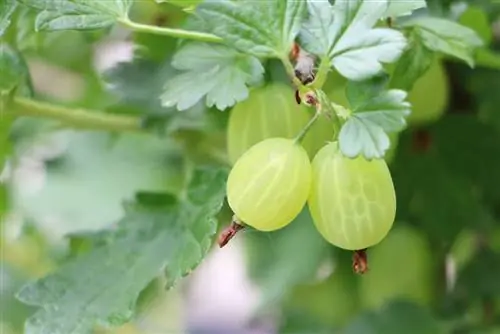
Regardless of whether you use strawberry plants or bushes, the soil should be enriched with nutrients. A liquid fertilizer that has been specially developed for berries provides a very good basis. If you want to use a solid fertilizer, that is also possible. However, you should make sure that you water well before planting the plants. Only then can the fertilizer bond well with the soil and the nutrients are distributed. Before planting the plants, it is important to loosen all of the soil.
Avoid digging a hole for each shrub or plant and adding fertilizer to it. This could give the plants an excess supply of nutrients. If the entire soil is not prepared, it is also possible that the nutrient supply will not be successful at all, for example because the fertilizer applied at certain points does not reach the plant. It is therefore advisable to prepare a larger area and fertilize in moderation. Only when irrigation or rain water has distributed the fertilizer well into the soil should you start planting the plants.
Keep the distance between bushes
When planting shrubs, it is important that you pay attention to the spacing. Currants need one meter of space. Even if it looks very bare at first, you will quickly notice the lush growth. The bushes grow in length and width and require space in order to develop.
Raspberries also need space to develop because they keep growing new shoots while the old shoots die off. When it comes to raspberries, make sure that they grow tall but only develop thin canes. Support from plant sticks or wooden walls to which they can be attached is advisable.
Important: The correct dosage of fertilizer
Regardless of whether you fertilize for the first time when planting the plants or later, you should always pay attention to the dosage. Using the fertilizer too often and too heavily will not ensure that the plants develop well, but can harm the plants. Each fertilizer is provided with a dosage recommendation, which you will find printed on the bottle or on the outer packaging. Be sure to note this dosage recommendation if you discard the packaging. It is considered an essential basis for optimally supplying plants with nutrients.
Do not damage the roots of the plants when planting them
You should only plant the plants after the soil has been optimally prepared. Pay attention to the roots. If possible, they should not bend or be damaged in any other way. Dig the hole big enough and only lay the soil loosely over it. Then water sufficiently before you tighten the soil a little. Afterwards, the plants need a lot of water so that they can connect to their new location.
Tip:
Transplanting is also possible with the different types of berries. Proceed in the same way as with new planting and ensure that the soil is well prepared.
The second step: choosing the right fertilizer
The selection of berry fertilizers is very large. Different manufacturers offer these fertilizers and you should know which criteria you should use to choose the right product. The most expensive product is not always the best. You often pay for the brand name. Pay more attention to the ingredients and make sure that the berry fertilizer really suits your plants. You get special fertilizer for strawberries, raspberries or other types of berries or you choose a universal berry fertilizer with a balanced combination of nutrients.
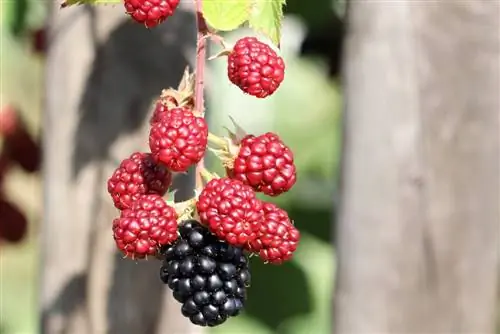
If you have other plants in your garden and you don't want to buy a separate fertilizer for each type of plant, you can also use a universal fertilizer. And finally you have the choice between a liquid fertilizer and a solid fertilizer. All variants have advantages and disadvantages that you should know before choosing a specific product.
Optimal fertilizer composition
You can buy fertilizers in a very large selection in stores, and there is a good reason for this. Plants differ in their requirements and the fertilizers are tailored to them. In general, you will not harm your berry plants if you accidentally or knowingly use flower fertilizer or lawn fertilizer. All fertilizers contain combinations of nutrients that are beneficial for plant growth.
But you will only get optimal results if you choose a fertilizer that is tailored to the needs of the berries. If you have a large garden with many plants, it is advisable to invest in various fertilizers. This is how you get a lushly blooming garden and benefit from a good harvest from your berry crops.
Berries require special active ingredients
Berry fertilizer is characterized by a mixture of organic and chemical fertilizers. If you have a compost pile in your garden, you can use only chemical fertilizers and use fresh compost instead of organic fertilizer. For berries it is optimal if you regularly receive organic nutrients. The composition of a chemical berry fertilizer includes the following elements:
- Nitrogen
- Phosphorus
- Potassium
If you decide to buy a berry fertilizer, you have the advantage that these components are present in the right mixture. Universal fertilizers are also suitable, especially if they contain a combination of these nutrients.
Liquid fertilizer or solid fertilizer - the advantages and disadvantages
Basically, you can use liquid and solid fertilizers to provide your berry plants with the most important nutrients. Both variants contain important components that stimulate the growth of the bushes and ensure a bountiful harvest. The fertilizers differ in how they are handled and in the strength of their effect. You should know the pros and cons. Alternatively, you can try both options and observe your berry plants to find out which fertilizer works best for you.
Solid fertilizers
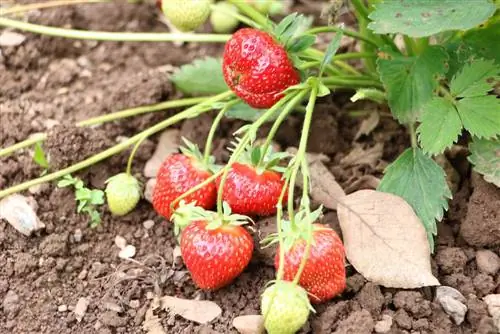
Solid fertilizers are granular or in powder form. They are scattered on the ground and dissolve when they come into contact with water. For this reason, it is important to water heavily after fertilizing or to time fertilization so that a heavy downpour disperses the fertilizer. Solid fertilizers have various advantages:
- high efficiency
- easy dosage
- suitable for very large areas
- Dosing with fertilizer cart possible
- cheap to purchase (compared to liquid fertilizer)
Solid fertilizers are more suitable for shrubs and plants that are planted directly in the ground. The fertilizers are more concentrated than liquid fertilizers and should therefore not be used in pots and tubs. It is also not recommended because the solid fertilizer does not dissolve well in the pot. You would have to water very heavily, which is not good for the plant. In addition, dosing the solid fertilizer in a small space is very difficult. Therefore, use liquid fertilizer for berries in pots and buckets.
Liquid fertilizer
Liquid fertilizer is added to the irrigation water. Basically it can be used for all types of plants. However, it was developed for pot and container plants. Since strawberries in particular, but also some raspberry varieties, are often kept on balconies and terraces, you can also get liquid fertilizer that was developed directly for berries.
The advantages of liquid fertilizer:
- easy to dose
- dissolves immediately in water
- very small quantities can also be dosed
- very productive
- particularly suitable for pots and buckets
The disadvantage that must be mentioned is that liquid fertilizer is more expensive than solid fertilizers in terms of quantity when purchased. You should also not use it outdoors. The reason for this is that the amount you would have to dose would be far too large. The yield is also lower because the liquid fertilizer is optimized for use in potted and container plants.
Tip:
Use solid fertilizers outdoors and liquid fertilizers in the pot, then you are always on the safe side.

